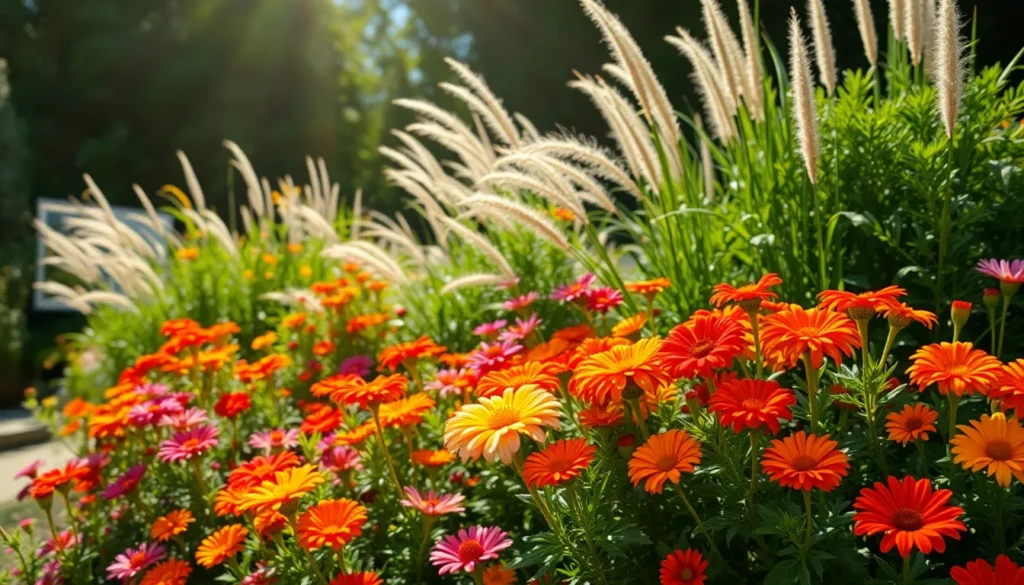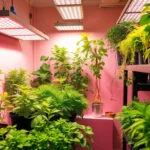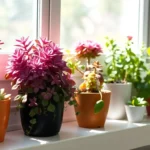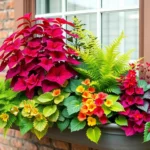When we’re designing our dream gardens we often face the challenge of filling those bright sunny spots that receive six or more hours of direct sunlight daily. These areas can feel like scorching deserts where most plants simply can’t survive – but that’s where choosing the right full-sun plants makes all the difference.
Full-sun plants aren’t just survivors – they’re showstoppers. These heat-loving champions don’t just tolerate intense sunlight; they absolutely thrive in it. From vibrant flowering perennials that bloom all season long to drought-resistant shrubs that require minimal maintenance we’ve discovered that sunny spots can become the most spectacular parts of our landscapes.
We’ll explore the best full-sun plants that’ll transform your brightest garden areas into stunning displays of color texture and fragrance. Whether you’re dealing with a south-facing border a sunny slope or that challenging spot by your driveway these sun-worshipping plants will help you create the garden oasis you’ve always wanted.
Understanding Full Sun Garden Conditions
We need to understand what full sun really means before selecting plants that’ll flourish in these bright conditions. This knowledge helps us make informed decisions about which plants will truly thrive in our sunniest garden spots.
What Qualifies as Full Sun Exposure
Full sun exposure means your garden area receives six to eight hours of direct sunlight daily during the growing season. Plants designated as full sun varieties require this intense light exposure to produce their best blooms, maintain compact growth, and develop strong root systems.
Morning sun typically provides the most beneficial light for plant photosynthesis and growth. Gardens facing south or west usually receive the longest periods of direct sunlight throughout the day. Areas with partial shade from nearby trees, buildings, or structures don’t qualify as full sun locations even if they seem bright.
We measure sunlight exposure by tracking shadows and light patterns in our garden spaces throughout different times of day. Digital light meters can provide precise measurements, but visual observation works well for most gardeners. Peak sunlight hours typically occur between 10 AM and 3 PM when the sun’s rays are strongest.
Soil and Water Considerations for Sun Plants
Sun loving plants often prefer well draining soil that doesn’t retain excessive moisture around their root systems. Sandy or loamy soil types work best for most full sun varieties because they prevent waterlogged conditions that can damage plant roots.
Soil temperature in full sun areas can reach significantly higher levels than shaded garden spots. We recommend adding organic matter like compost or aged manure to improve soil structure and water retention without creating soggy conditions. Mulching around plants helps regulate soil temperature and conserve moisture during hot summer months.
Watering requirements vary dramatically among full sun plants, with some species being extremely drought tolerant while others need consistent moisture. Deep, infrequent watering encourages strong root development better than frequent shallow watering. Early morning watering reduces evaporation losses and gives plants time to absorb moisture before peak heat hours.
Climate Zone Impact on Plant Selection
Climate zones determine which full sun plants will successfully overwinter in your exact geographic location. USDA Hardiness Zones range from 1 (coldest) to 11 (warmest) and help us identify plants that can survive local winter temperatures.
Plants rated for your exact zone or colder zones will typically survive winter conditions in your area. We always check both cold hardiness and heat tolerance when selecting plants for full sun locations. Some plants that thrive in full sun in cooler climates may struggle with intense heat in warmer zones.
Regional factors like humidity levels, rainfall patterns, and seasonal temperature variations affect plant performance beyond basic zone ratings. Coastal areas often have more moderate temperatures but higher humidity levels compared to inland locations at similar latitudes. Desert regions require plants with exceptional drought tolerance and heat resistance capabilities.
Colorful Annual Flowers That Thrive in Full Sun
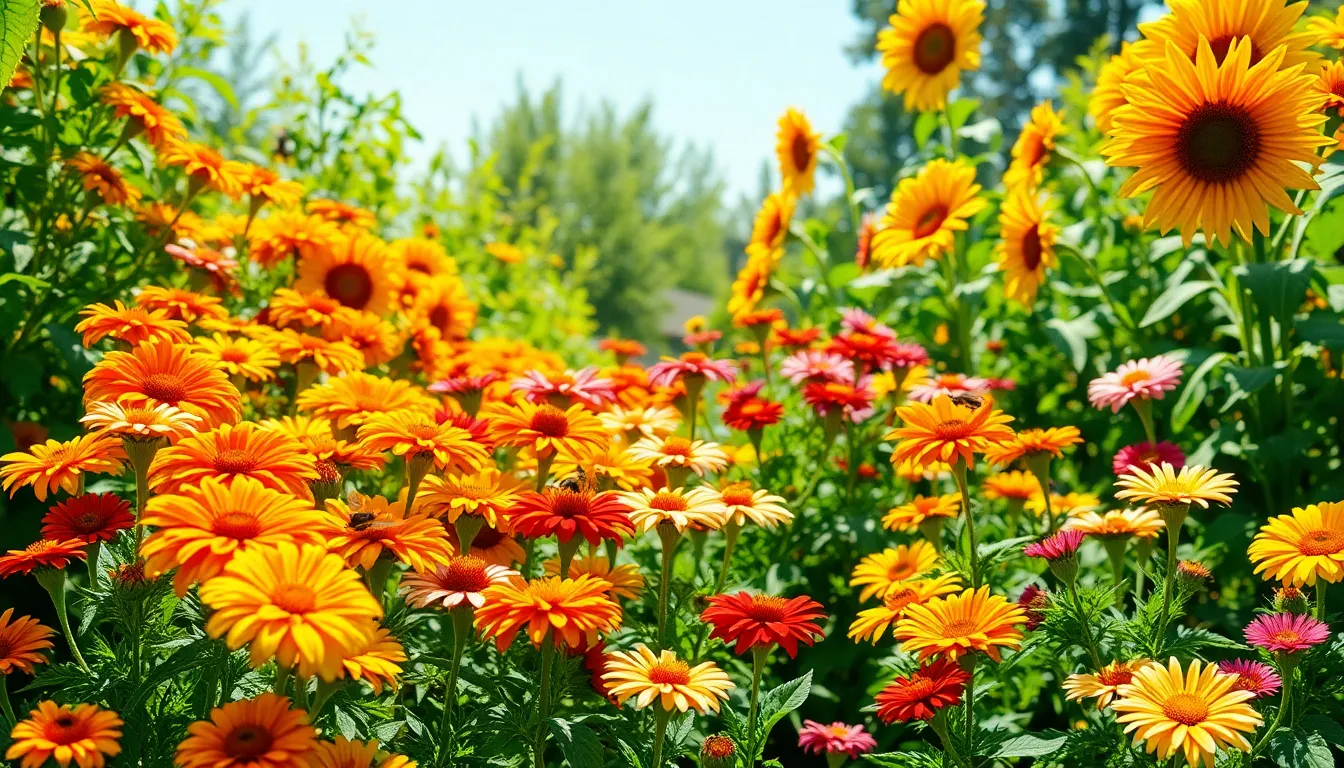
Annual flowers provide instant color and continuous blooms throughout the growing season, making them perfect for sunny garden spots. We’ve selected three standout varieties that deliver exceptional performance in full sun conditions.
Marigolds for Vibrant Summer Color
Marigolds stand out as dependable performers in the hottest, sunniest garden locations. These cheerful annuals produce bold blooms in brilliant shades of gold, orange, and yellow from spring until the first frost. Heat tolerance makes them ideal for areas where other flowers might struggle during peak summer temperatures.
Pest-repelling properties add functional value beyond their ornamental appeal. Marigolds naturally deter aphids, whiteflies, and certain nematodes from garden beds. We recommend planting them near vegetables or other susceptible plants for natural pest protection.
Compact varieties like French marigolds reach 6-12 inches tall, while African marigolds can grow up to 3 feet high. Both types require minimal maintenance once established and continue blooming without deadheading, though removing spent flowers encourages more prolific flowering.
Zinnias for Long-Lasting Blooms
Zinnias flourish in full sun exposure and reward gardeners with abundant, daisy-like flowers throughout the growing season. These easy-to-grow annuals produce blooms in an impressive color range including vibrant pinks, deep reds, bright oranges, sunny yellows, and pure whites.
Seed starting makes zinnias accessible for budget-conscious gardeners. Direct sowing in warm soil produces strong plants that often self-seed for the following year. We suggest spacing plants 6-12 inches apart depending on the variety size.
Cut flower potential ranks zinnias among the best garden-to-vase options. Sturdy stems support large flower heads that last 7-10 days in arrangements. Dwarf varieties work well in containers, while tall types like State Fair zinnias can reach 3-4 feet for dramatic garden displays.
Drought tolerance develops as plants mature, making them suitable for xeriscaping and low-water gardens. Once established, zinnias require watering only during extended dry periods.
Sunflowers for Dramatic Height and Impact
Sunflowers create bold vertical elements that transform sunny garden spaces with their impressive stature and iconic appearance. These towering annuals demand full sun exposure to achieve their maximum height potential and develop large, striking flower heads.
Size variety ranges from compact 2-foot dwarf types perfect for containers to giant varieties exceeding 10 feet in height. We recommend choosing varieties based on available space and desired garden impact.
Pollinator attraction makes sunflowers valuable for supporting beneficial insects and birds. Bright yellow petals surround dark centers rich in nectar and pollen. Mature seed heads provide food for birds well into fall and winter months.
Growing requirements include deep, well-draining soil and consistent moisture during the establishment period. Tall varieties may need staking in windy locations to prevent stem breakage. Plant seeds directly in the garden after soil temperatures reach 60°F for best germination rates.
Perennial Powerhouses for Sunny Locations
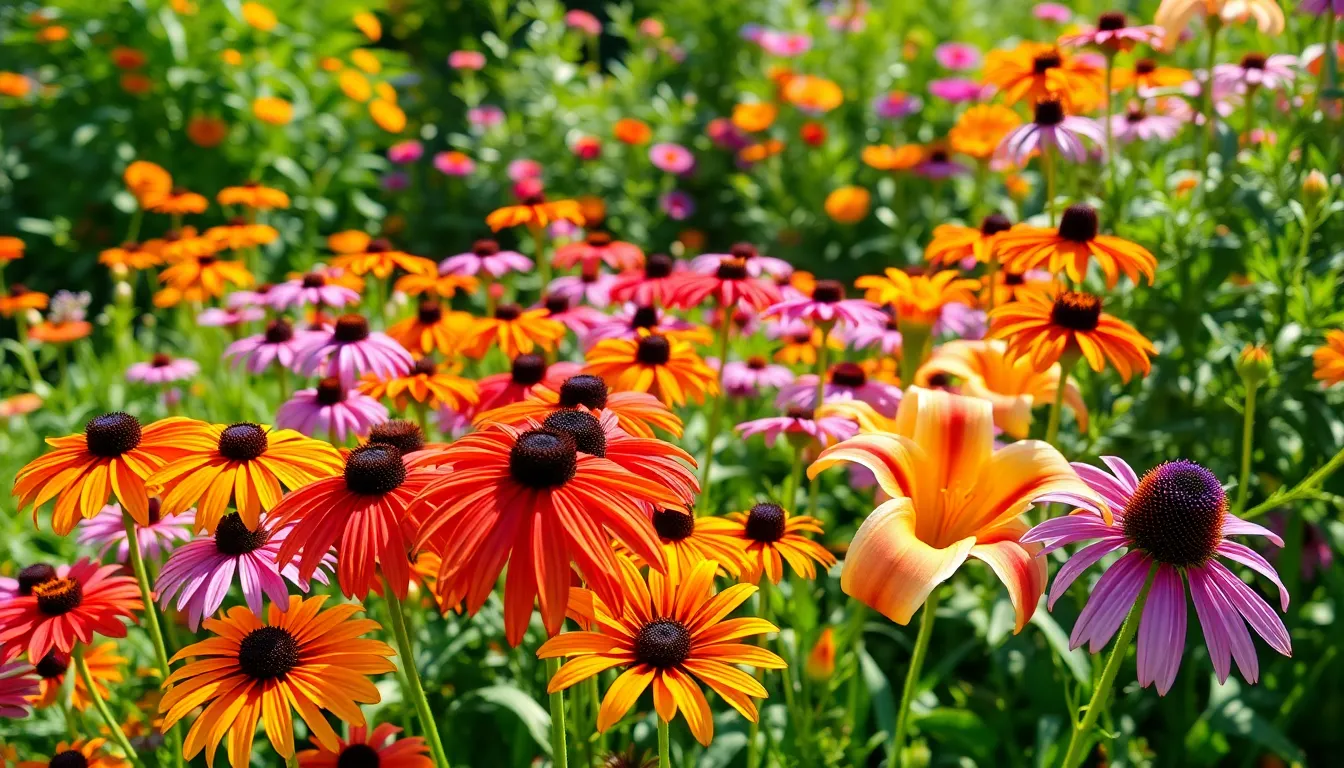
While annuals provide instant color, perennials offer lasting value that returns year after year. These hardy plants require at least six hours of direct sunlight daily and create the foundation of successful sunny gardens.
Black-Eyed Susans for Year-Round Beauty
Black-eyed Susans (Rudbeckia spp.) deliver bright yellow petals with distinctive dark centers that create stunning visual impact in full sun locations. We recommend these classic perennials for their exceptional drought tolerance and ability to thrive in hot conditions where other plants struggle. Their moderate height makes them perfect for borders and mass plantings throughout sunny garden areas.
Blooming extends throughout the growing season, providing continuous color when many other plants fade. Heat resistance allows black-eyed Susans to maintain their vibrant appearance even during summer’s most intense periods. Structure remains attractive long after blooming ends, adding winter interest to garden beds.
Purple Coneflowers for Wildlife Appeal
Purple coneflowers (Echinacea spp.) showcase striking purple-pink flowers with daisy-like forms that attract essential pollinators to sunny garden spaces. Butterflies and bees consistently visit these blooms, creating a thriving network in full sun areas. We’ve observed their remarkable ability to withstand hot conditions while supporting wildlife throughout the growing season.
Drought tolerance makes purple coneflowers reliable performers in challenging sunny locations. Seedheads develop after blooming, providing food sources for birds during fall and winter months. Their ecological benefits extend beyond the growing season, supporting garden wildlife year-round.
Daylilies for Low-Maintenance Color
Daylilies (Hemerocallis spp.) thrive in full sun conditions while requiring minimal care from busy gardeners. Sequential flowering creates repeated bursts of color as individual blooms open over extended periods. We appreciate their ability to adapt to various soil types and their impressive drought resistance once established.
Care requirements remain minimal compared to other flowering perennials in sunny locations. Wide range of colors and sizes allows for versatile design options in full sun gardens. Reliability makes daylilies excellent choices for gardeners seeking beautiful results without intensive maintenance demands.
Heat-Tolerant Vegetables Perfect for Full Sun Gardens

Growing vegetables in full sun gardens brings its own rewards and challenges. We’ll explore the best heat-tolerant vegetable options that thrive under intense sunlight.
Tomatoes for Maximum Harvest
Tomatoes require full sun exposure but face challenges when temperatures consistently exceed 90°F. We recommend providing afternoon shade or applying mulch around the base to keep roots cool during extreme heat periods. Managing soil moisture becomes critical since high temperatures can inhibit fruit set and reduce overall yields.
Selecting heat-adapted varieties helps ensure consistent harvests throughout the growing season. Determinate types often perform better in scorching climates than indeterminate varieties. Proper watering techniques and soil preparation create the foundation for successful tomato cultivation in sunny gardens.
Peppers for Spicy Garden Success
Peppers represent some of the most heat-tolerant vegetables available for full sun gardens. Hot pepper varieties like jalapeños, serranos, and shishito peppers handle blazing temperatures significantly better than tomatoes or bell peppers. These plants flourish in hardiness zones 9-11 where consistent warm temperatures promote abundant production.
Sweet pepper options include banana peppers and pimento peppers that also perform exceptionally well under full sun conditions. Implementing proper watering practices and mulching strategies helps maintain plant health even during extreme heat periods. Regular harvesting encourages continued fruit production throughout the hottest months.
Squash and Cucumbers for Sprawling Growth
Squash varieties, particularly summer squash, adapt remarkably well to full sun and high heat conditions. These sprawling plants require ample garden space to accommodate their extensive growth patterns. Providing consistent soil moisture through mulching prevents root stress during temperature extremes.
Cucumbers thrive in full sun exposure with optimal growing temperatures between 50°F and 95°F. Maintaining adequate soil moisture becomes essential for preventing heat stress and ensuring continuous fruit production. We suggest using organic mulch to retain moisture and keep root zones cooler during peak summer heat.
Additional heat-tolerant vegetables include okra, which flourishes in dry, warm soil conditions and produces finger-like green pods. Green beans, especially French bean varieties, prefer full sun locations and warm growing conditions for optimal performance.
Drought-Resistant Succulents and Cacti
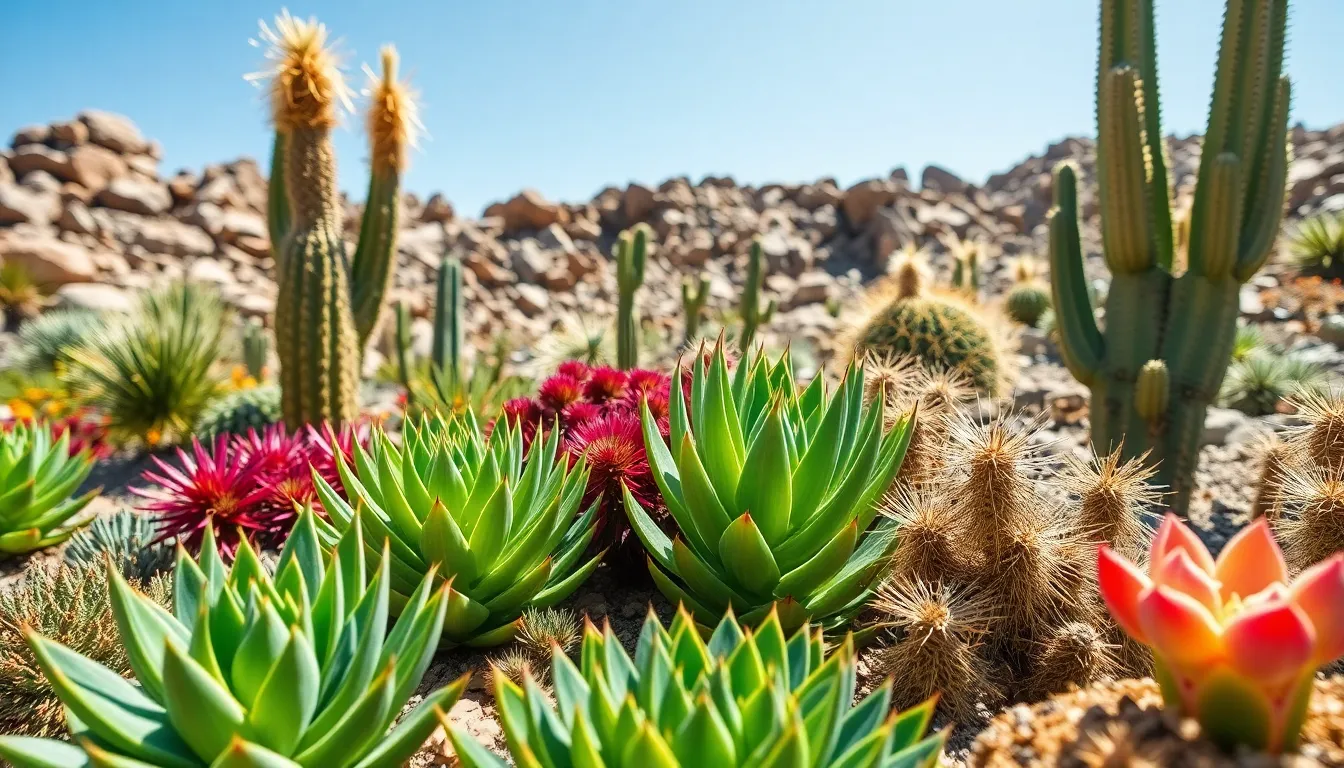
We’ve explored vibrant annuals and hardy perennials, but drought-resistant succulents and cacti offer the ultimate solution for challenging full sun locations. These remarkable plants store water in their fleshy leaves or stems, allowing them to thrive where other plants struggle.
Sedum Varieties for Ground Cover
Sedum plants create exceptional ground cover answers for full sun areas with their low water requirements and spreading growth habits. They naturally reduce soil erosion while adding beautiful texture and color to sunny landscapes throughout the growing season. Waterwise gardens benefit tremendously from sedums because they tolerate poor soils and require minimal maintenance once established.
Established sedum varieties spread easily across open areas, forming dense mats that suppress weeds effectively. Their drought tolerance makes them perfect for slopes, rock gardens, and areas where regular watering isn’t practical. Many sedums produce colorful flowers that attract beneficial pollinators during blooming periods.
Aloe Plants for Vertical Interest
Aloe plants bring architectural drama to sun exposed gardens with their distinctive rosette formations and tall flower spikes. Their fleshy leaves create striking vertical accents that contrast beautifully with low growing ground covers and spreading plants. Desert themed landscapes particularly benefit from aloe’s sculptural presence and year round visual appeal.
Varieties range from compact species perfect for containers to larger specimens that command attention as focal points. Well drained soil is essential for aloe success, but once established, these plants require very little water or care. Their flower spikes emerge seasonally, adding bursts of orange, red, or yellow blooms high above the foliage.
Prickly Pear Cactus for Desert Appeal
Prickly Pear cactus (Opuntia species) delivers authentic desert beauty while supporting local wildlife in full sun gardens. These cacti range from 12 inches to 6 feet tall with variable spreads, offering options for different industry scales and design needs. Their colorful pads provide striking contrast against traditional garden plants and maintain visual interest throughout all seasons.
Wildlife enthusiasts appreciate how Prickly Pear supports birds and rabbits seeking shelter and food sources. The edible fruit adds practical value to gardens, as it can be harvested for jams and jellies with potential health benefits including cholesterol reduction. Xeriscape landscapes gain instant authenticity and character when we incorporate these striking cacti into sunny borders and rock gardens.
Ornamental Grasses That Love Full Sun
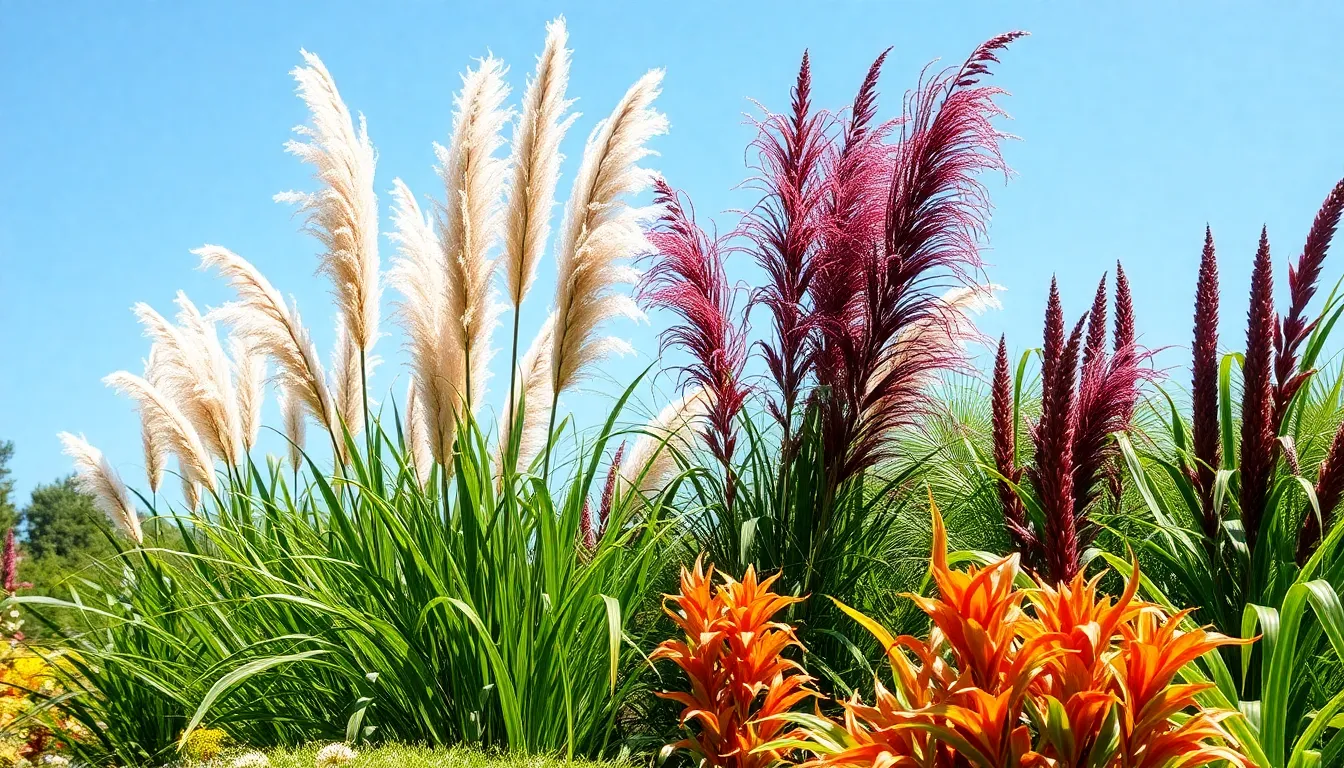
Ornamental grasses bring movement and texture to full sun gardens in ways that traditional flowers simply can’t match. We’ll explore three exceptional varieties that transform sunny spaces with their unique characteristics and year-round appeal.
Fountain Grass for Textural Elements
Fountain grass creates stunning visual interest with its graceful, arching foliage and distinctive feathery flower spikes. We recommend this drought-tolerant perennial for gardeners seeking soft, flowing textures that dance in the breeze. Pennisetum species thrive in full sun locations and well-drained soil conditions, requiring minimal maintenance once established.
Growing Requirements:
- Sunlight: 6+ hours of direct sun daily
- Soil: Well-draining sandy or loamy soil
- Water: Drought tolerant; deep watering weekly until established
- Height: 2-4 feet depending on variety
Border plantings benefit tremendously from fountain grass’s architectural qualities, while accent installations create focal points throughout the industry. Seasonal interest peaks during late summer when the feathery plumes emerge, providing texture that persists well into winter months.
Ornamental Corn for Seasonal Interest
Ornamental corn varieties deliver unique autumn appeal that transforms full sun gardens during fall months. We suggest incorporating these distinctive plants for their colorful foliage and decorative ears that enhance seasonal displays. Maize cultivars prefer full sun exposure and produce their most vibrant colors when grown in bright, open locations.
Seasonal Benefits:
- Summer: Tall, dramatic foliage creates vertical interest
- Fall: Colorful ears and changing leaf colors
- Winter: Dried stalks provide structural elements
Container gardens showcase ornamental corn beautifully, while border plantings create stunning backdrops for shorter plants. Harvest timing occurs in late summer through early fall when ears reach full maturity and display their most vibrant colors.
Pampas Grass for Statement Landscaping
Pampas grass commands attention with its impressive height and spectacular plume-like flower heads that create bold industry statements. We use Cortaderia selloana in large garden spaces where its dramatic presence can truly shine without overwhelming smaller plants. Full sun exposure brings out the best in pampas grass, encouraging robust growth and prolific plume production.
Industry Applications:
- Backdrop plantings: Creates privacy screens up to 10 feet tall
- Focal points: Single specimens anchor large garden beds
- Wind barriers: Dense growth provides natural windbreaks
Maintenance requirements remain surprisingly low for such an impressive plant, with annual cutting in late winter being the primary care task. Drought tolerance makes pampas grass ideal for xeriscaping projects and low-water garden designs, while its adaptability to various soil types ensures success in most full sun locations.
Shrubs and Small Trees for Sunny Spots

Shrubs and small trees create the backbone of any successful full sun garden by adding structure, height, and seasonal interest to complement our colorful annuals and perennials. These larger plants thrive with at least six hours of direct sunlight daily and offer long-term garden answers that mature beautifully over time.
Butterfly Bush for Pollinator Gardens
Butterfly bush (Buddleja) attracts adult butterflies and honey bees with its abundant nectar production, creating vibrant pollinator activity throughout the growing season. We love how its long-lasting flower spikes come in purple, blue, pink, white, and red varieties, offering endless design possibilities for sunny gardens. Easy to grow and blooming over extended periods, this shrub supports generalist pollinators with reliable nectar sources.
But, we must acknowledge butterfly bush’s important ecological drawbacks before planting. Invasive tendencies allow it to spread rapidly and outcompete native species, threatening local plant biodiversity in many regions. While it attracts adult butterflies beautifully, the plant fails to support complete pollinator lifecycles since caterpillars can’t feed on its foliage. Monopolizing pollinator attention, butterfly bush can distract beneficial insects from native plants and reduce native species’ reproductive success.
We recommend managing butterfly bush growth carefully and considering native alternatives like milkweed, buttonbush, and meadowsweet for better ecological support in our pollinator gardens.
Rose Bushes for Classic Beauty
Rose bushes provide timeless elegance in full sun gardens with their fragrant, colorful blooms that work beautifully in both formal and informal industry settings. We appreciate how these classic garden plants reward our regular care with repeated flowering cycles throughout the growing season. Well-drained soil and consistent maintenance help roses deliver spectacular color displays in various shades and forms.
Versatility makes roses excellent choices for sunny spots where we want reliable beauty and traditional garden charm. Their fragrant blooms create sensory experiences while adding sophisticated appeal to our industry designs.
Crape Myrtles for Multi-Season Appeal
Crape myrtles (Lagerstroemia) excel as small trees or large shrubs that provide year-round interest with vibrant summer flowers, attractive bark patterns, and brilliant fall foliage displays. We find these plants perfect for full sun locations in warm climates where they develop their characteristic multi-season beauty. Summer flowers bloom in stunning shades of pink, white, red, and purple, creating spectacular focal points in our sunny gardens.
Versatile industry applications make crape myrtles valuable additions where we need height, color, and seasonal transitions. Their attractive bark adds winter interest while fall foliage provides spectacular autumn displays that extend garden appeal beyond the growing season.
Planning Your Full Sun Garden Layout

Creating a strategic garden layout maximizes sun exposure while ensuring each plant receives optimal growing conditions. We’ll arrange taller plants toward the back or center and position shorter varieties at the edges for better visibility and maintenance access.
Companion Planting Strategies
Lavender paired with roses creates an excellent pest-deterring combination that thrives in full sun conditions. We recommend planting lavender around rose bushes to naturally repel harmful insects while both plants enjoy similar light and water requirements.
Bee balm near vegetable gardens attracts essential pollinators while adding vibrant color to sunny spaces. Position this flowering perennial close to tomatoes and peppers to increase fruit production through enhanced pollination.
Marigolds as protective borders effectively repel nematodes and other soil-dwelling pests that damage plant roots. We use these bright annuals around the perimeter of vegetable plots and flower beds for natural pest control.
Mixed layered plantings combine flowering perennials with ornamental grasses and ground covers for resilient landscapes. Group plants with similar water and light needs together to create efficient care zones while maintaining visual appeal.
Seasonal Succession Planning
Early spring bloomers like iris and peony provide the first burst of color when temperatures warm. We select these hardy perennials to establish garden interest before summer’s intense heat arrives.
Summer flowering stars including echinacea and coreopsis maintain continuous color during peak growing season. Plant these drought-tolerant perennials alongside heat-loving annuals like zinnias and marigolds for extended blooming periods.
Late season performers such as sedum and aster extend garden beauty into fall months. We incorporate these plants to bridge the gap between summer’s end and winter dormancy.
Annual color boosts fill mid-season gaps with quick-growing flowers that bloom until frost. Strategic placement of sunflowers and cosmos provides dramatic height variations and attracts beneficial wildlife.
Maintenance Tips for Sun-Loving Plants
Mulching retains soil moisture and suppresses weed growth around full sun plants. We apply 2-3 inches of organic mulch like shredded bark or compost to protect root systems from temperature extremes.
Deep infrequent watering encourages strong root development that helps plants withstand drought conditions. Water thoroughly once or twice weekly rather than daily shallow watering to promote resilience.
Deadheading spent flowers extends blooming periods for perennials like coneflowers and black-eyed susans. We remove faded blooms regularly to redirect plant energy into producing new flowers.
Pruning overcrowded stems maintains proper air circulation that prevents fungal diseases in humid conditions. Remove dead or crossing branches during dormant seasons to keep plants healthy and vigorous.
Sparse fertilization prevents excessive soft growth that attracts pests and reduces heat tolerance. We apply balanced fertilizer sparingly in spring and avoid high-nitrogen feeds during summer months.
Conclusion
We’ve equipped you with everything needed to transform those challenging sunny spots into thriving garden showcases. From vibrant annuals to sturdy perennials drought-resistant succulents to architectural grasses your full sun areas can become the most spectacular parts of your industry.
Success comes from matching plants to your exact conditions and following proper care techniques. With strategic planning thoughtful plant selection and consistent maintenance your sunny garden will reward you with seasons of color fragrance and wildlife activity.
Start small choose plants suited to your climate zone and watch as your confidence grows alongside your beautiful sun-loving garden.
Frequently Asked Questions
What qualifies as a full sun garden location?
A full sun location receives six to eight hours of direct sunlight daily. Gardens facing south or west typically get the most sunlight. Areas with partial shade don’t qualify as full sun spots, even if they seem bright.
What type of soil works best for full sun plants?
Well-draining sandy or loamy soils are ideal for most full sun plants. Good drainage prevents root rot, while these soil types allow plants to establish strong root systems that can handle intense sunlight and heat.
How should I water plants in full sun gardens?
Use deep, infrequent watering to promote strong root development. This method helps plants become more drought-resistant and better equipped to handle intense sunlight compared to frequent shallow watering.
Which annual flowers are best for sunny spots?
Marigolds, zinnias, and sunflowers are excellent choices. Marigolds repel pests and bloom vibrantly, zinnias offer long-lasting flowers with drought tolerance, and sunflowers provide dramatic height while attracting pollinators.
What perennial plants thrive in full sun?
Black-eyed Susans, purple coneflowers, and daylilies are top choices. These perennials offer continuous color, attract pollinators, require minimal maintenance, and create a lasting foundation for sunny gardens.
Can I grow vegetables in full sun gardens?
Yes, many vegetables thrive in full sun. Tomatoes, peppers, squash, cucumbers, okra, and green beans all perform well with six-plus hours of direct sunlight daily, though they need consistent moisture management.
Are succulents good for full sun locations?
Absolutely. Sedum varieties, aloe plants, and prickly pear cacti excel in full sun with minimal water requirements. They add unique textures and colors while supporting sustainable, low-maintenance gardening practices.
How do I arrange plants in a full sun garden?
Place taller plants at the back or center, with shorter varieties at the edges for optimal visibility. Use companion planting strategies like pairing lavender with roses, and plan for seasonal succession to ensure continuous blooms.
What maintenance do full sun plants need?
Apply mulch to retain moisture, practice deep watering, deadhead spent blooms, and prune as needed. Use fertilizer sparingly to prevent soft growth that attracts pests and reduces heat tolerance.

